Our Evaluation Criteria: How We Ranked the APIs
We know how difficult it can be to find a reliable ranking built on clear, transparent criteria. So, true to our own advice, here are the criteria we followed when evaluating a wide range of translation APIs and selecting the top 10:
- Translation accuracy. This ranking focuses on APIs that offer fluent, context-aware translations and handle idioms and technical jargon. NMT (Neural Machine Translation) was a plus.
- Language support. We selected APIs with a wide language and dialect coverage, as well as language detection capabilities for a more dynamic interface.
- Performance. The APIs featured here have low latency, and many of them are suitable for applications requiring real-time translation.
- Core features. We searched for APIs with capabilities beyond basic word-to-word translation. Glossary support for brand names, document translation, and formality control are some of the features we prized the most.
- Developer experience. How easy it is to integrate each API, and whether they have clear, extensive documentation and keep well-maintained SDKs, were also key points for assessing them.
- Pricing. Last but not least, we considered that the best translation APIs of 2025 should offer a transparent and predictable pricing structure, flexible enough to suit various needs, and leave enough room for scalability.
Want to communicate seamlessly with customers? Explore our guide on the best SMS APIs of 2025.
The Top 10 Translation APIs of 2025
So, now that you know the criteria we followed, it’s time for you to discover which translation APIs are the best of 2025, according to our ranking. Ready to unlock the power of saying ‘Hello!’ in over 100 languages and dialects? Here’s our top 10 choice:
Google Cloud Translate
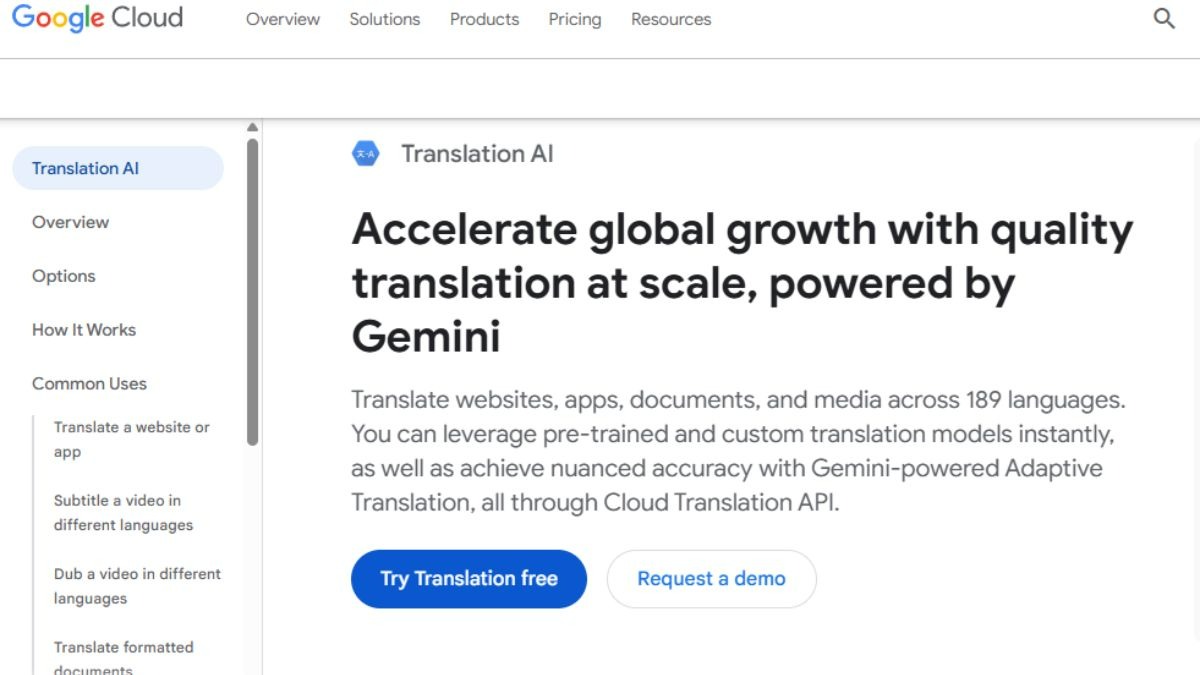
Best for: Fast, scalable translations with broad language detection and enterprise-grade accuracy.
Google Cloud Translate allows developers to easily integrate advanced translation into their projects, helping deliver content that resonates globally. It offers a Basic version powered by NMT for context-aware fluency, and an Advanced option that incorporates LLMs for building custom models.
Key features include:
- Automatic language detection.
- Glossaries and support for 189 languages.
- Real-time translation for web and mobile apps.
- Text and document translation (PDF, Office, Google Workspace).
Pricing: Pay-per-character, billed monthly. The first 500,000 characters are free each month. Custom model training is billed separately.
Why it Made the List: This API combines quality, wide coverage (189 languages), low latency, and deep API integration with Google Cloud. Its customization options make it one of the top translation APIs available in 2025. for developers and enterprises alike.
DeepL API
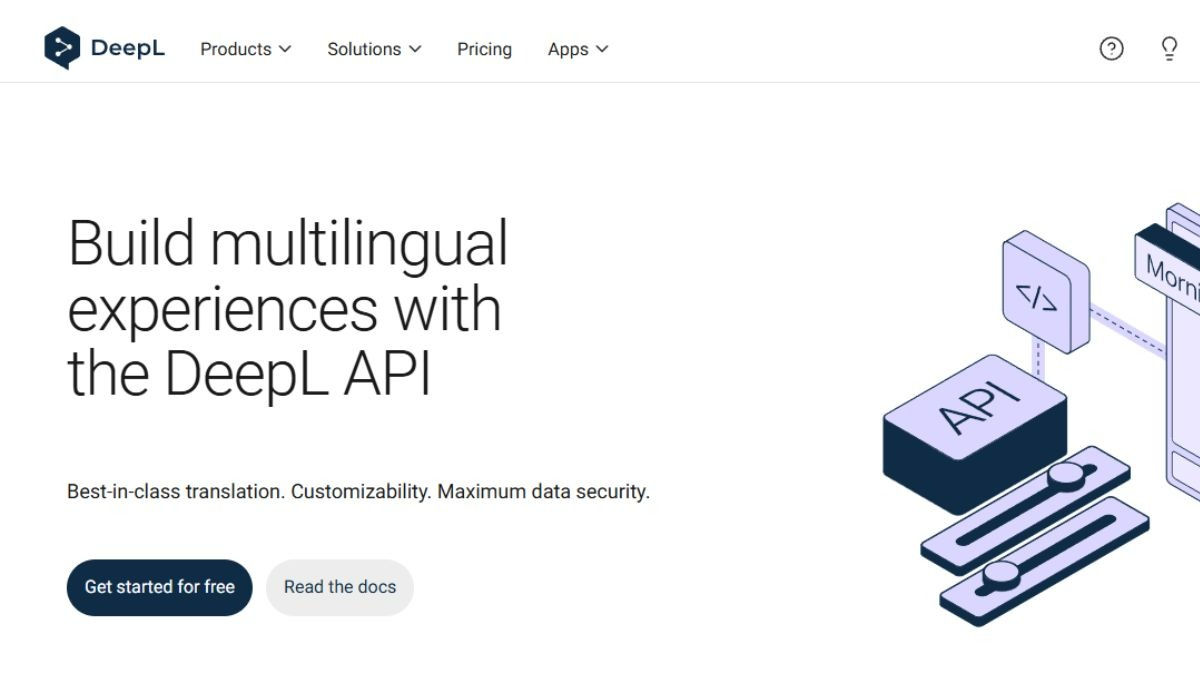
Best for: Natural-sounding translations with superior accuracy, especially in European languages.
The DeepL API uses advanced NMT models trained on bilingual sources. While language support is more limited than some competitors, it is particularly suited for translating idiomatic expressions and nuanced language with top-notch contextual precision.
Key features include:
- Automatic language detection.
- Formality control (formal/informal).
- Document translation (.docx, .pptx, PDF).
- Support for HTML and XML.
Pricing: Free plan with 500,000 characters/month. The Pro API plan offers up to 1,000 glossaries, pay-as-you-go pricing ($25 per 1M characters). Custom plans are available.
Why it Made the List: Beyond its exceptional translation quality, this API is designed to be easy to use. It offers strong documentation, simplifying integration and troubleshooting. All of these make it one of the most reliable translation APIs in 2025.
Ensure your translations reach the right audience with Abstract’s IP Geolocation API.
Microsoft Translator

Best for: Apps requiring enterprise-grade features, scalability, and seamless integration with the Azure ecosystem.
Microsoft Translator API has an intuitive interface and simple integration that allows you to easily convert text from one language to another. It also supports translations into multiple languages simultaneously. Built on NMT, it delivers context-sensitive accuracy, though LLM-powered customization is still limited to some languages.
Key features include:
- Automatic language detection and transliteration.
- Real-time translation for text and speech.
- Context-sensitive NMT.
- Document translation.
Pricing: Free plan includes 2M characters/month, and custom translation. Paid options use pay-as-you-go or commitment tiers. Disconnected containers and Commitment plans are available for high-volume needs.
Why it Made the List: Microsoft Translator earned a spot on our top translation APIs of 2025 ranking because of its strong language coverage, low latency, and native Azure scalability, making it a dependable API for enterprises operating globally.
Amazon Translate
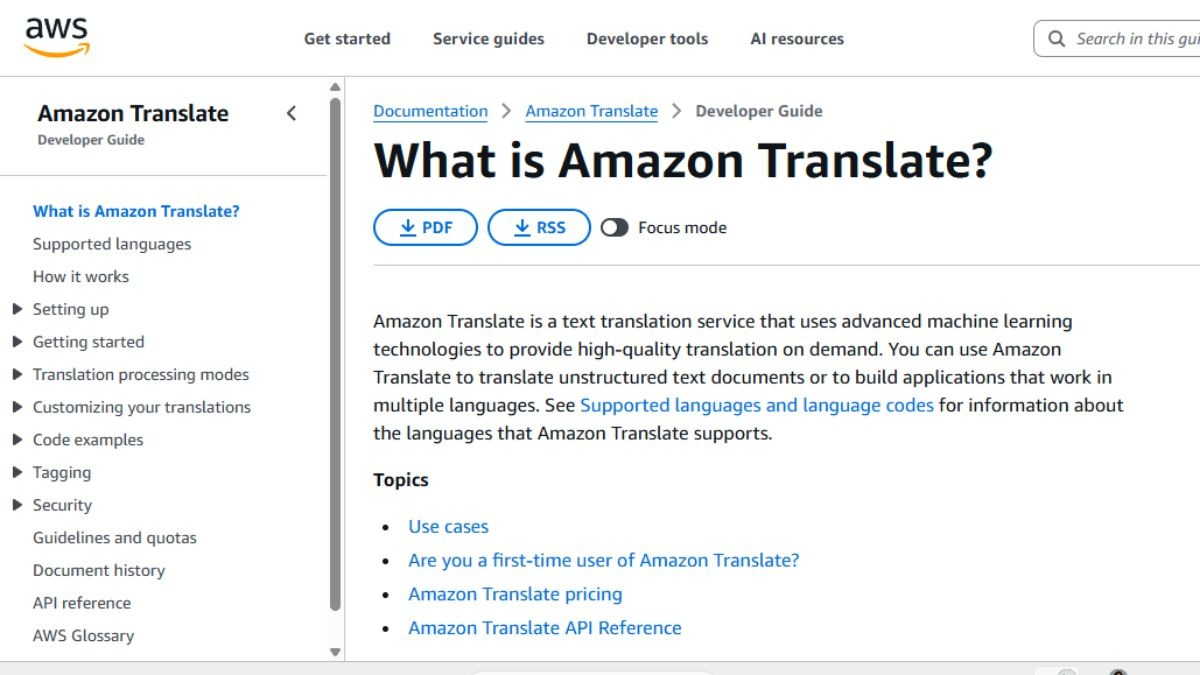
Best for: AWS developers needing scalable, customizable translation solutions.
Amazon Translate is an NMT service that uses cutting-edge algorithms to produce accurate real-time translations. This API handles a wide range of content formats, including plain text, HTML, and document formats. It is optimized for integration within AWS, providing flexibility for diverse applications.
Key features include:
- Automatic language detection.
- Support for +70 languages and glossaries.
- Customization with domain tuning.
- Robust API documentation.
Pricing: Pay-per-character. New users get 2M characters free for their first year (standard and batch translations only).
Why it Made the List: Amazon Translate is a developer-friendly API with wide language coverage, strong AWS integration, and flexible customization. All of these, along with its straightforward pricing model, make it one of the top translation APIs in 2025.
Tilde MT API

Best for: Enterprises needing dialect coverage and domain-specific customization.
The Tilde MT (Machine Translation) API supports a wide range of languages and dialects, with options to deploy either in the cloud or on-premise. This produces highly customized translations, making it popular in academic, governmental, and enterprise settings.
Key features include:
- NMT with domain-specific tuning.
- Plain text, document, and website translation.
- Glossary support and formality control.
- API can be trained with parallel data.
Pricing: Customized, based on use case and deployment model.
Why it Made the List: This translation API offers cutting-edge technology, coverage for uncommon languages, and advanced customization. Also, the documentation is crystal clear, simplifying integration.
Managing teams in different countries? Keep communication in sync with Abstract API’s Time, Date & TImezone API.
Libre Translate API
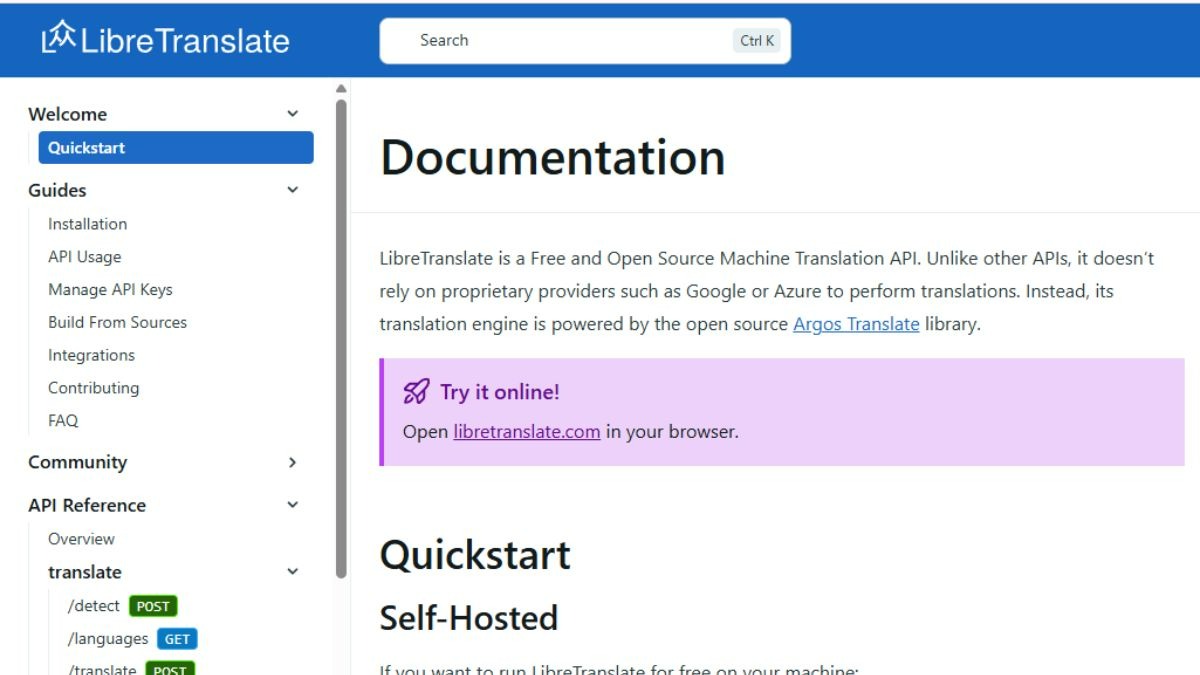
Best for: This translation API is perfect for self-hosted and privacy-focused apps requiring open-source flexibility.
Libre Translate is an open-source API, powered by Argos Translate, that specializes in NMT translations. It is designed for privacy-conscious developers who prefer to avoid third-party cloud dependencies. Although language coverage is modest, this API stands out for its flexibility and freedom to customize.
Key features include:
- Automatic language detection.
- Support for customization.
- Self-hostable and managed hosting options.
- Translation of HTML/Markup text.
Pricing: This API is free when self-hosted. Managed hosting requires an API key, with Pro (80 translations/min) and Advanced (200 translations/min) paid tiers.
Why it Made the List: Libre Translate provides accessible, customizable translations for developers needing full control over deployment and data privacy. All of this, along with its flexibility, makes this API stand out among some of the best translation software of 2025.
Modern MT

Best for: Translation solutions requiring adaptive machine capabilities for domain-specific content.
ModernMT delivers context-sensitive translations across 200 languages and regional dialects. The ex-Translated API offers adaptive NMT, incorporating flexible, real-time training capabilities to deliver greater accuracy over time. Though this translation API is for enterprise usage, it also integrates with CAT tools for professional translators.
Key features include:
- Automatic language detection.
- Glossary and document support (71 file formats).
- Cloud and on-premise deployment.
- CAT Tools integration.
Pricing: Two paid plans: Human-in-the-Loop and Adaptive. Both start at $15/mo for 1M characters. Adaptive includes a free trial month and Human-in-the-Loop, background checks by professional translators.
Why it Made the List: Not only does Modern MT offer an extensive language coverage and adaptive learning, but it also has a minimum of 95% uptime and low latency. With its limit of 50K characters for single API requests, it offers scalable, reliable results, making it one of the best translation APIs of 2025.
Need to pinpoint the exact location of your website users? Here’s our ranking of the top 10 IP geolocation WordPress plugins.
Yandex Translate

Best for: Affordable, scalable translations with strong Russian and surrounding languages support.
The Yandex Translate API provides NMT services for over 100 languages, with an easy-to-use interface. It integrates seamlessly with Yandex Cloud to provide enterprise reliability.
Key features include:
- Automatic language detection.
- 99% uptime with SLA.
- Glossary support.
- Flexible quotas for scalability.
Pricing: Yandex Translate is billed per character and language detection request. Pricing depends on the region and may vary according to the exchange rate.
Why it Made the List: This translation API offers an excellent combination of affordability and scalability. Yandex Translate combines solid customization with strong SLA-backed uptime and reliability, making it suitable for building robust multilingual apps.
My Memory API
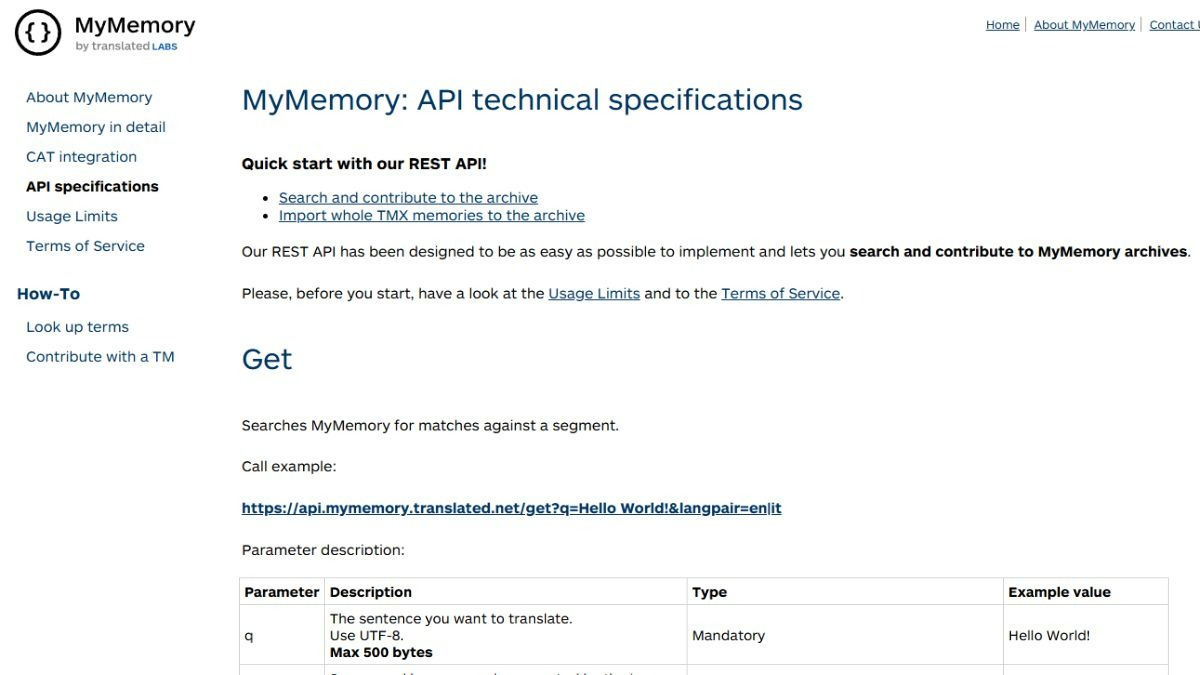
Best for: CAT workflows leveraging human-edited translation memories rather than pure NMT.
MyMemory API is one of the top translation APIs of 2025. This software stands out for providing accurate and culturally relevant results, based on a combination of machine translation with user-uploaded translation memories. It is typically used within professional CAT environments.
Key features include:
- CAT integration.
- Professional translator-sourced memories.
- Suitable for small to high-volume usage.
- Professional translator-sourced memories.
Pricing: The free Basic plan includes 10,000 words/month. Pro and Ultra tiers increase limits at significantly higher costs.
Why it Made the List: While not a translation API on itself, but rather a “sourcing” one, the My Memory API is one of the best options available for powering CTA. By blending human and machine translations, it delivers precise context-aware results, making it a valuable tool for professional translation apps.
Lingvanex API

Best for: Versatile cloud or on-prem apps with large user bases.
Lingvanex API offers a simple cloud solution for integrating translation functionalities, as well as a scalable, customizable on-premise version for enterprise deployments.
Key features include:
- Automatic language detection and HTML/document translation.
- Context-aware NMT with AI enhancements.
- Support for 109 languages and industry idioms.
- GDPR/CCPA compliance.
Pricing: The cloud API includes 200K free characters as a welcome gift. Lingvanex on-prem plans are fixed per language, with unlimited processing.
Why it Made the List: This translation API combines affordability, reliability, and advanced compliance. It also balances affordability with GDPR/CCPA compliance, making it a strong option for businesses prioritizing security and flexibility.
How to Choose the Right API for Your Project
Now that you know which translation APIs are worth considering in 2025, let’s focus on how to choose the one that best fits your project. After all, advanced features and broad coverage mean little if they don’t match your actual needs.
Here’s what to keep in mind when choosing between translation APIs that seem equally strong:
- Does the API cover your target languages and dialects? Make sure it supports every language your current and projected audiences may need, not just the major ones.
- Is the translation fluent and context-aware? Does the API recognise technical jargon, idioms, or brand terms, or support customization?
- Can you train the API with your own data or apply domain-specific glossaries for better results? Do you have access to the data required for such training?
- Does it offer cloud-based or on-prem displays? How challenging is it to integrate and manage the API? Are clear documentation, customer support, SDKs, and code samples available?
- How scalable is the API? Check quotas, maximum request sizes, price changes, and latency to ensure it will work for your project’s current and future needs.
- Can you afford its pricing in the long term? Can you access a free tier for testing? Which payment models does it support?
- Are there any relevant extra features you may need (eg, document or speech translation, formality control, etc.)?
Answering these will help narrow down your options. Still unsure? Here are some safe bets:
Conclusion: The Right API, The Right Words
When it comes to translating text and other content, developers have a wide range of tools at their disposal. Choosing the “best” translation API isn’t about a universal winner, but about finding the right fit for your project. Google Cloud Translate leads in scale, DeepL stands out for quality, and other providers excel in areas like self-hosting (LibreTranslate), adaptive learning (ModernMT), or enterprise customization (Tilde MT).
Finding the perfect API may seem daunting. By evaluating each option against clear, transparent criteria, you can move beyond marketing claims and choose a tool that truly empowers your application and connects with a global audience.
Great projects run on great APIs. Ready to start building? Pick the translation API your project needs, and complement it with a strong set of APIs that enhance customer experience and functionality.
Build smarter with Abstract API, made by developers, for developers.



